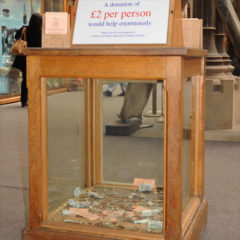A Nudge From The World’s Most Famous Prison

Getting the average person to donate money to a tourist attraction, no matter how historic, is a challenge. That’s doubly true for international visitors who may not see the site as part of their identity or history. But the UK’s Tower of London has adopted a smart strategy that comes straight out of the Nudge playbook.
The Tower of London is one of the city’s top attractions. At various times, it has been a palace, a fortress, and a prison. Today, among other features, it displays the Crown Jewels. Of course, the cost of maintaining and operating a site like this is enormous. Like many museums, the Tower of London relies not just on ticket sales but donations to balance its books.
What Most Museums Do
 Some attractions I’ve visited have a visible donation repository near the entrance that allows visitors to drop in a contribution. For example, with typical understated British reserve, the Oxford University Museum of Natural History uses what itself looks like a historic museum display case to point out that a £2 contribution would “help enormously.”
Some attractions I’ve visited have a visible donation repository near the entrance that allows visitors to drop in a contribution. For example, with typical understated British reserve, the Oxford University Museum of Natural History uses what itself looks like a historic museum display case to point out that a £2 contribution would “help enormously.”
The illustration of the box on the museum’s website shows a smattering of coins and currency lining the bottom of the box. While the photo may not be at all representative of the daily contribution, it’s likely the majority of visitors give the box a pass. (And, a big box with few donations provides rather weak social proof. Might it not be better to have a smaller box stuffed with £5 and larger notes? That would suggest most people give, as well as anchor a higher donation level. If you want to add to the Oxford museum’s box, go here.)
What the Tower of London Does
 The Tower of London administrators take a more aggressive stance to collecting donations. Unlike most museums which structure any contribution as an opt-in choice, the Tower admission tickets include a voluntary contribution by default. By turning the contribution into a “must opt out” vs “must opt in,” the Tower converts a far higher percentage of visitors into contributors.
The Tower of London administrators take a more aggressive stance to collecting donations. Unlike most museums which structure any contribution as an opt-in choice, the Tower admission tickets include a voluntary contribution by default. By turning the contribution into a “must opt out” vs “must opt in,” the Tower converts a far higher percentage of visitors into contributors.
Does It Work?
I think this strategy works at multiple levels. Many visitors will never read the fine print and simply pay the posted price. Others will notice the voluntary contribution text but assume that making the donation is what most people do since it’s the default. And, those who read the fine print will find that the inclusive prices are fluent round numbers while the net prices are odd numbers. (Do you really want a pocketfull of coins?) And, of course, a few visitors will demand the lower price.
The Tower of London has been a prison, a palace, and a fortress. Today, it offers a lesson in #BehavioralEconomics. Share on X
I asked a ticket seller at the Tower about the voluntary donation and the behavior of visitors. She estimated just one in five asked for the lower, donation-free price. If her experience is at all representative of the overall participation rate, it means that four out of five visitors are voluntary donors – an amazing conversion rate.
The UK’s Behavioral Insights Team, a.k.a. the “Nudge Unit,” employs luminaries like Daniel Goldstein and Nobelist Richard Thaler to develop science-based interventions to further public policy objectives. The BIT website doesn’t list Historic Royal Palaces, the independent charity that operates the Tower of London, as a client. But, the latter’s smart approach to maximizing donations from one-time visitors could well have been inspired by the UK nudge experts.
